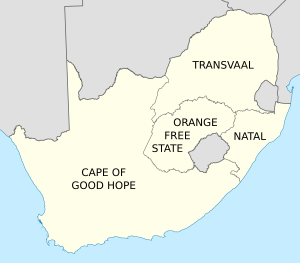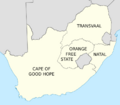South Africa Act 1909 facts for kids
| Act of Parliament | |

|
|
| Long title | An Act to constitute the Union of South Africa. |
|---|---|
| Citation | 9 Edw. 7. c. 9 |
| Territorial extent | Union of South Africa |
| Dates | |
| Royal assent | 20 September 1909 |
| Commencement | 31 May 1910 |
| Repealed | 31 May 1961 (South Africa) 27 May 1976 (United Kingdom) |
| Other legislation | |
| Amended by | Status of the Union Act, 1934 |
| Repealed by | Republic of South Africa Constitution Act, 1961 (South Africa) Statute Law (Repeals) Act 1976 (United Kingdom) |
|
Status: Repealed
|
|
The South Africa Act 1909 was an important law passed by the Parliament of the United Kingdom. This law created the Union of South Africa. It brought together four British colonies: the Cape, Natal, Orange River, and Transvaal.
The Act also suggested that Rhodesia could join the Union later. However, people in Rhodesia voted against this idea in 1922. The plan for the Union was supported by the parliaments of the four colonies. But the leader of the Cape Colony, W. P. Schreiner, was worried. He feared the Act would take away rights from non-white South Africans.
This Act was the third big law from the British Parliament to unite different British colonies. It also gave them some control over their own affairs. Similar laws had created Canada in 1867 and Australia in 1900.
Contents
How the Union of South Africa Began

After the Anglo-Boer War (1899–1902), Britain took control of two independent Boer republics. These were the South African Republic and the Orange Free State. Britain renamed them the Transvaal Colony and the Orange River Colony. They joined Britain's other lands in South Africa: the Cape Colony and Natal.
The British government wanted these four colonies to unite. In 1907, the Transvaal and Orange River colonies gained more self-rule. This made many Afrikaner people also want a closer union.
These ideas led to the National Convention in 1908. This meeting started on October 12, 1908, and finished on May 11, 1909. At this meeting, they decided how the new Union would be governed. They also planned its laws and economy.
These plans were sent to the British government. The British Parliament then created a bill to make these wishes come true. The bill became law on September 20, 1909. On that same day, King Edward VII announced that the Union of South Africa would begin on May 31, 1910.
This Act was like the first constitution for South Africa. It lasted for over 50 years. During this time, South Africa gained more independence from Britain. Even when South Africa became a republic in 1961, parts of the 1909 Act remained. However, the last parts of the 1909 Act were removed in 1983. This happened when a new constitution was put in place during the apartheid era.
What the Act Did
How the Government Worked
The government of the Union of South Africa was set up like other British Dominions. A Governor-General of South Africa was chosen to represent the British Monarch. The Monarch was also the King or Queen of South Africa.
The Governor-General and an Executive Council held the main power. The Prime Minister of South Africa quickly became the head of the government. The Prime Minister and other government ministers had to be members of Parliament. The Governor-General usually chose the leader of the biggest political party as Prime Minister.
The power to make laws belonged to the Parliament. This Parliament included the Monarch, a Senate, and a House of Assembly. Each province had an equal number of representatives in the Senate. Senators were chosen by members of the House of Assembly and provincial lawmakers.
In the House of Assembly, each province had members based on its population. These members were elected from different areas within each province. The House of Assembly had more power than the Senate. This was similar to the House of Commons and House of Lords in the UK.
If the Senate and House of Assembly disagreed on a law, the Governor-General could call a joint meeting. Both houses would meet to discuss and vote on the law. The House of Assembly was much larger than the Senate. This system was designed to give the House of Assembly more power in these joint meetings.
The Act also created a Supreme Court of South Africa. This court system had local, provincial, and appellate (appeal) divisions. The highest court was the appellate division, located in Bloemfontein.
Each province had an Administrator, chosen by the central government. Each province also had a Provincial Council to make local laws. Four members of this Council, along with the Administrator, formed a committee. This committee acted like the province's cabinet.
Unlike Canada and Australia, South Africa became a single, central state. The four provinces had much less power than Canadian provinces or Australian states. South Africa's government was very similar to the United Kingdom's government structure.
Voting Rights in the Cape
The Cape Colony had a system where all men could vote if they met certain requirements. These rules applied to everyone, no matter their race. During the talks to form the Union, leaders from the Cape Colony tried to extend this system to all of South Africa. But they failed. The white governments of the other colonies wanted to keep white rule.
The South Africa Act allowed the Cape Province to keep a limited version of its voting system. This meant that some "coloured" (mixed-race) and Black African men could still vote in the Cape. They had to meet certain education and wealth rules. The Act also gave the new South African Parliament the power to set all other voting rules.
However, the Act said that Parliament could change the Cape's voting rules with a two-thirds vote. Over the years, new laws were passed. These laws slowly removed the voting rights of non-white people.
In 1931, most voting rules were removed for white voters, except for the age limit. But these rules stayed for Black and "Coloured" voters. In 1956, the apartheid government took away all remaining voting rights for "non-whites." This event is known as the Coloured vote constitutional crisis.
Overall, the Act did not do much to protect Black Africans. It allowed for over 50 years of racial discrimination and apartheid to be established.
Other Important Rules
The Act made English and Dutch the official languages of South Africa. They had equal status under the law. All government papers and Parliament meetings had to be published in both languages. Today, English is still one of the official languages of the Republic of South Africa. Dutch was later changed to include Afrikaans in 1925. Afrikaans then replaced Dutch in the 1961 Constitution.
Images for kids




